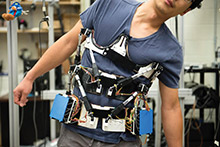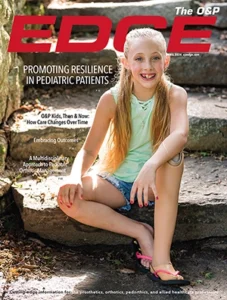
A prototype of the wearable spinal brace. Sensors record the force and motion data and transmit the information to a computer for monitoring and treatment. Photograph by Jane Nisselson, courtesy of Columbia University.
About 2 to 3 percent of children are diagnosed each year with adolescent idiopathic scoliosis (AIS); one in 500 children with AIS require treatment using spinal bracing. The typical spinal brace is made of rigid plastic, which restricts movement, and as the child grows, the required external forces to correct the abnormal posture change along the length of the curve and over the course of treatment. Having the flexibility to move when wearing a spinal brace while still applying corrective forces would be a very useful feature for both patients and physicians. To address this, a team of engineering and medical professors are developing a dynamic brace for children with AIS.
Sunil Agrawal, PhD, a professor of mechanical engineering and of rehabilitation and regenerative medicine at Columbia University, is collaborating with David P. Roye, MD, St. Giles Foundation Professor of Pediatric Orthopedic Surgery at the Columbia University Medical Center (CUMC), New York, and Charles Kim, PhD, an associate professor of mechanical engineering at Bucknell University, to develop a dynamic brace that is more flexible than the rigid braces now in use. They have just won a $1 million grant from the National Science Foundation’s (NSF’s)National Robotics Initiative to pursue their work.
Agrawal and his team have already developed prototype wearable spinal braces that consist of rings that fit on the human torso. These rings are dynamically actuated by servomotors placed on adjacent rings to control the force or position applied on the human body. Onboard sensors record the force and motion data and transmit the information to a host computer for monitoring and adjusting the treatment. The team has also developed a second brace that is fully passive, made of compliant components able to adjust stiffness in specific directions. However, both these braces have drawbacks. The dynamic brace needs an active power source while the passive brace cannot provide active controls.
“While we are the first group to propose parallel-actuated spine braces and compliant braces, these are just in initial phases,” Agrawal explained. “What we will do, thanks to the NSF award, is to design hybrid semi-active spine braces that combine the merits of the two. These will be less power hungry and can be worn over a longer duration of time.”
The team, which has drawn together experts in robotics and pediatric orthopedics, plans to test all three types of braces on children with scoliosis at CUMC. Preliminary experiments have already started to characterize the feasibility of the dynamic braces on healthy subjects with normal spines to characterize the body’s stiffness in different directions during activities of daily living.
“Scoliosis impacts the quality of life of those affected, limiting their activity, causing pain, and diminishing their self-esteem,” Agrawal added. “We expect our work will transform treatment due to the ability of the brace to modulate force or position at specific locations of the spine and will greatly improve the quality of life for children with this debilitating condition.”
Editor’s note: This story was adapted from materials provided by Columbia University.




